Affiliate disclosure: This post may contain affiliate links. Please see our Privacy Policy.
Raspberry wine captures the flavor (and stunning color) of fresh summer raspberries for year-round sipping.
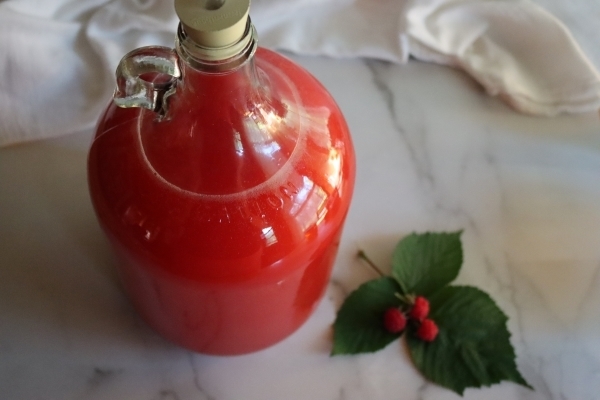
Raspberry wine is absolutely spectacular, and the fruit flavors really shine through in the finished wine. Raspberries are naturally tart and acidic, so they’re already most of the way towards a balanced wine.
They need a bit of sugar since they don’t have anywhere near as much fermentable sugar as grapes and a small amount of added winemaking tannin to add body and a pleasant mouthfeel.
You’ll also need a bit of yeast nutrient, to help feed the yeast and a packet of wine yeast.
Beyond that, the process is quite simple, provided you’re patient enough to allow the wine to ferment to completion, and then bottle age to perfection.
If you’ve never made wine, I’d recommend reading this beginner’s guide to small-batch wine before you get started. I’ll take you through all the steps in any case, but sometimes it’s good to have a foundation to understand the terminology and basic process.
You can also convert this raspberry wine recipe to a raspberry mead recipe simply by changing the sugar for honey. If you’re curious, here’s where you can learn the basics of making mead (honey wine).
This recipe for raspberry wine is adapted from The Joy of Home Winemaking. Though the book contains literally hundreds of wine recipes for just about every type of fruit under the sun (plenty of vegetables and herb wines too).
Of course, he also covers everything you need to know for making wine from grapes as well.
I’ve made a number of the country wine recipes in this book, and they’ve all been spectacular. This recipe for raspberry wine is no exception.
The author notes that:
“This is my favorite wine, bar none. I make some every year and guard it jealously. It is served only to special guests and given away only to people I really like and respect. Made well, this wine is fragrant, subtle, dry, and goes well with anything except heavy tomato and meat dishes.”
The author also insists that this wine is really best with fresh-picked raspberries, and made the day they’re picked, and I definitely agree. We have row after row of raspberries, and I pick them fresh from the yard. If you don’t have homegrown raspberries, put in the effort and go down to the local pick your own for the best fruit, it’s really worth it.
You can, of course, make raspberry wine with frozen raspberries (or even canned raspberries), and it’ll still be wonderful….just not quite as absolutely spectacular. Still worth making though!
This raspberry wine recipe also works wonderfully with fresh black raspberries (blackcaps).
Equipment for Raspberry Wine
The equipment you’ll need is pretty minimal, and there are always substitutions using common kitchen or household items in a pinch.
For the basics, you’ll need:
- Narrow Neck Carboy (Demijohns) with Water Lock ~ This vessel is used for fermentation. Ideally, you’ll need two carboys—one for primary fermentation and another for transferring the wine to after the initial stage.
- Siphon ~ A siphon helps transfer the wine from one container to another without disturbing the sediment at the bottom of the fermentation vessel. This is also essential for bottling the finished wine.
- Bottles ~ For short-term aging under a few months, you can use flip-top Grolsch bottles. For longer-term aging suggested for mead, use wine bottles, corks, and a wine corker.
- Fine Cheesecloth (90 grade) or a Drawstring Brewing Bag ~ This is used to suspend the raspberries in the liquid during the initial fermentation to extract their flavors (while keeping their pulp/seeds contained so it doesn’t make a mess).
Ingredients for Raspberry Wine
Making a gallon of homemade raspberry wine isn’t all that different from making any type of small-batch fruit wine.
You’ll need the following ingredients:
- 3 3/4 quarts water, filtered & unchlorinated
- 2 1/2 lbs sugar (or 2 3/4 lbs mild honey for mead)
- 3 to 4 lbs raspberries, fresh or frozen
- 1/2 tsp. acid blend
- 1/8 tsp. tannin powder
- 1 tsp yeast nutrient
- 1/2 tsp. pectic enzyme
- 1 packet Montrachet Wine Yeast or Champagne Yeast
Yeast for Raspberry Wine
The choice of yeast actually really impacts the final flavor, sweetness, and ABV% of the finished wine. Yeast contributes flavor as well as alcohol as a byproduct of its metabolism, and some contribute floral fruit flavors…while others ferment clean without impacting flavor much at all.
The yeast’s alcohol tolerance will play a roll as well, as they stop working and die off once they reach their limit, meaning that more residual sugar is left if you use a yeast with lower alcohol tolerance.
Any wine yeast will do in a pinch, but I’d suggest Red Star Premier Côte des Blancs, which is known to contribute fine, fruity aromatics to a finished wine. It also has a low alcohol tolerance (around 13%), so the finished wine will have some residual sweetness.
Another good choice is Montrachet Wine Yeast, which is a dependable fermenter and makes full-bodied fruit wines full of complex fruity aromatics. It’s similar to Red Star Premier Côte des Blancs in character, but it’s also known for helping to maintain bright colors in the finished wine.
If you choose generic champagne wine yeast, which is a vigorous fermenter and good for just about anything, it’ll finish at around 18% alcohol resulting in a much dryer wine without as much fruity aroma.
Instructions for Making Raspberry Wine
Start by picking over the raspberries, removing any that are moldy or underripe. Wash the fruit and place them in a fine-mesh brewing bag, or a fine-mesh strainer lined with cheesecloth (as I’ve done below).
If in a mesh bag, place it inside a plastic fermenter (minimum 2 gallons), or suspend the mesh strainer with cheesecloth over the fermenter.
Bring the water and sugar to a hard boil on the stove, stirring to dissolve the sugar. Pour the boiling water over the fruit. The hot water will help set the color of the fruit, ensuring a bright red finished wine.
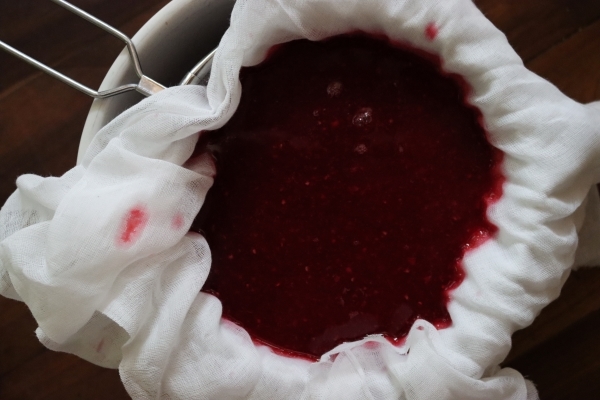
Tie the berries into the cheesecloth, and drop them into the fermenter. If you have a brewing bag, skip this step, as the berries are already in a bag in the fermenter.
Add the acid blend, tannin, and yeast nutrients. Stir to dissolve and incorporate.
Allow the mixture to cool completely until it’s at room temperature. Once cool, add the pectic enzyme and yeast packet.
Cover the bucket with a towel and allow the mixture to ferment in the bucket for 7 to 10 days. This is known as primary fermentation, and you don’t need a water lock at this point.
During primary fermentation, the yeast are getting going and the initial fermentation can be pretty vigorous. At this point, a water lock would just clog with debris. Be sure to stir the mixture daily during primary to keep the raspberry bag in the mixture.
After 7-10 days, the fermentation should be less vigorous, and it’s time to move the mixture into a fermenter with a water lock.
Remove the raspberry bag and use a siphon to transfer the wine to a narrow neck 1-gallon glass carboy (demijohns). Add water to fill if necessary.
Cap with a water lock and allow the mixture to ferment in secondary for 4 to 6 months.
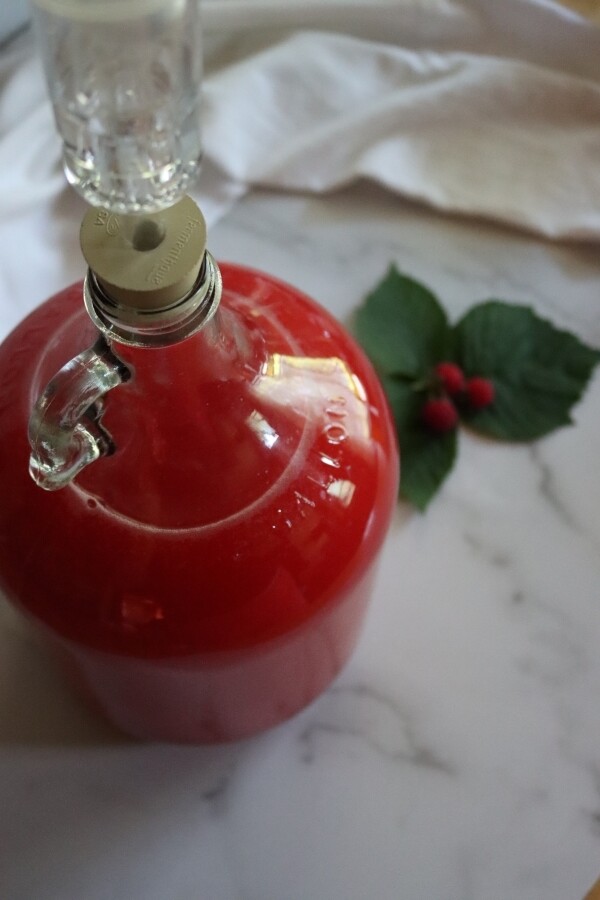
During the secondary, be sure to rack the wine off its sediment at least once. Leaving this wine on the “lees” or dead yeast at the bottom of the fermenter for too long will result in off-flavors.
To rack, just use a siphon to transfer the wine to another carboy, topping off with water or dry neutral white wine if necessary to fill. Be sure to re-seal the water lock.
After 4-6 months, it’s time to bottle the wine. If it’s too dry for your tastes, add another 1/4 pound of sugar and rack it into a clean fermenter for another month before bottling.
(If it’s still too dry for your tastes, repeat the process again, adding another 1/4 lb and re-racking into a clean container.)
This one-gallon batch raspberry wine recipe should yield about 4 standard wine bottles.
Allow the wine to bottle condition for at least 1-2 months, preferably much longer, before drinking. If you intend to age the wine for more than 6 months, I’d recommend using corked wine bottles. In a pinch, for short-term aging, you can use flip-top Grolsch bottles.
Ways to Preserve Raspberries
Looking for more ways to preserve raspberries?
Winemaking Recipes
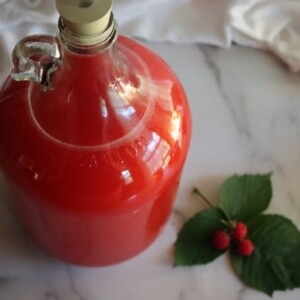
Raspberry Wine
Ingredients
- 3 3/4 quarts water, filtered and unclorinated
- 2 1/2 lbs sugar, or 2 3/4 lbs mild honey for mead
- 3 to 4 lbs raspberries, fresh or frozen
- 1/2 tsp. acid blend
- 1/8 tsp. tannin powder
- 1 tsp yeast nutrient
- 1/2 tsp. pectic enzyme
- 1 Packet Montrachet Wine Yeast, or Champagne Yeast
Instructions
- Pick over the raspberries, removing any moldy fruit, stems, and leaf material. Wash the fruit and place them mesh brewing bag or tie them into a bit of cheesecloth to keep them contained.
- Place the bag of raspberries into a plastic fermenter (minimum 2 gallons).
- Bring the water and sugar to a hard boil on the stove, stirring to dissolve the sugar. Pour the boiling water over the fruit. The hot water will help set the color of the fruit, ensuring a bright red finished wine.
- Add the acid blend, tannin, and yeast nutrients. Stir to dissolve and incorporate. Don’t add the yeast at this point! The boiling water is good for extracting color and dissolving everything, but it’ll kill the yeast.
- Allow the mixture to cool completely until it’s at room temperature. Once cool, add the pectic enzyme and yeast packet.
- Cover the bucket with a towel and allow the mixture to ferment in the bucket for 7 to 10 days. This is known as primary fermentation, and you don’t need a water lock at this point.
- After 7-10 days, the fermentation should be less vigorous. and it’s time to move the mixture into a fermenter with a water lock. Remove the raspberry bag and use a siphon to transfer the wine to a narrow neck 1-gallon glass carboy (demijohns). Add water to fill if necessary.
- Cap with a water lock and allow the mixture to ferment in secondary for 4 to 6 months. During the secondary, be sure to rack the wine off its sediment at least once, after a month or two in secondary. To rack, just use a siphon to transfer the wine to another carboy, topping off with water or dry neutral white wine if necessary to fill. Be sure to re-seal the water lock.
- After 4-6 months, it’s time to bottle the wine. If it’s too dry for your tastes, add another 1/4 pound of sugar and rack it into a clean fermenter for another month before bottling. (If it’s still too dry for your tastes, repeat the process again, adding another 1/4 lb and re-racking into a clean container.)
- Bottle the wine in wine bottles with corks, or in a pinch, you can use flip-top Grolsch bottles for short-term storage. If you plan on aging the wine for much more than 6 months, I’d recommend corked bottles. Either way, allow the wine to bottle condition for at least 1-2 months before drinking, preferably longer.
Easy Winemaking Recipes
Looking for more easy winemaking recipes?
Fermented Drinks
Why not ferment something else in your kitchen too?
- Traditional Kvass
- How to Make Mead
- How to Make Hard Cider
- How to Make Pear Cider (Perry)
- Sima (Finnish Fermented Lemonade)
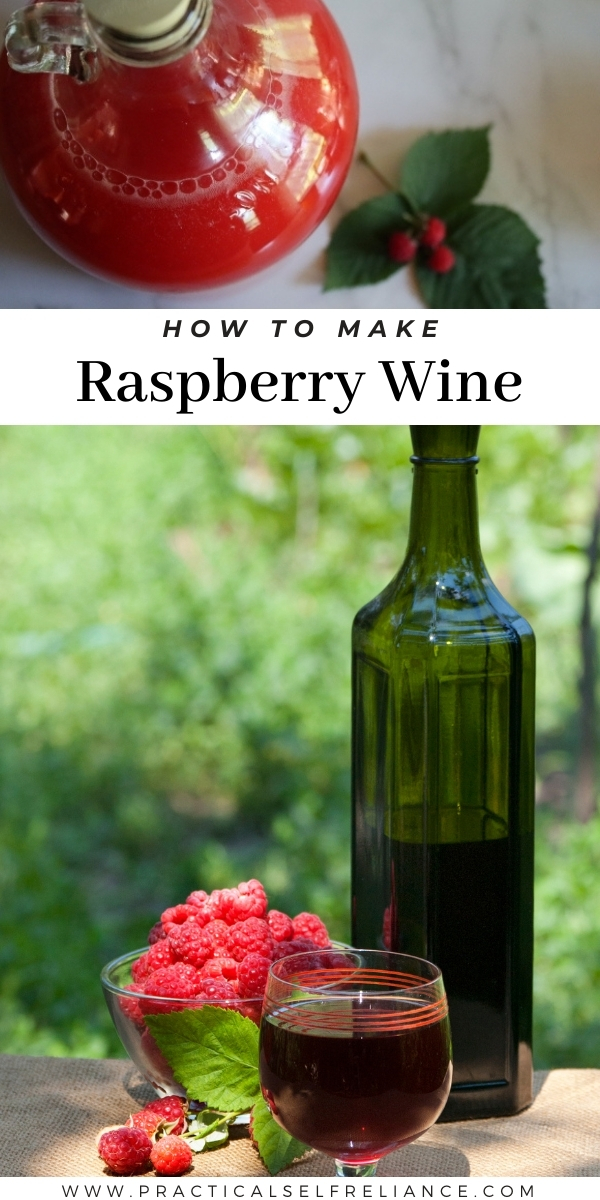

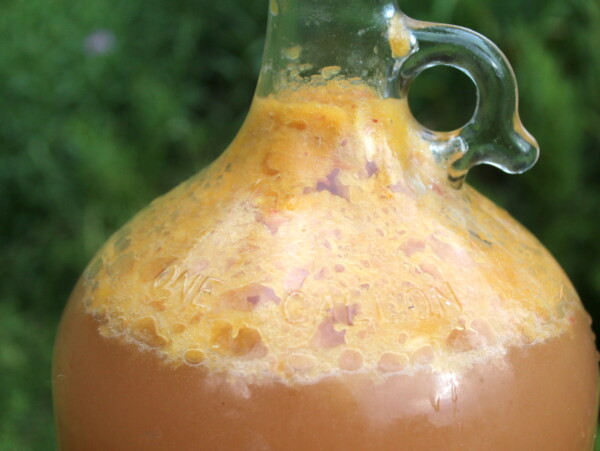
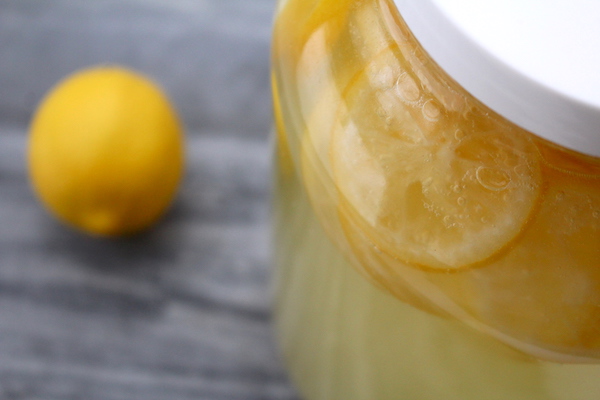



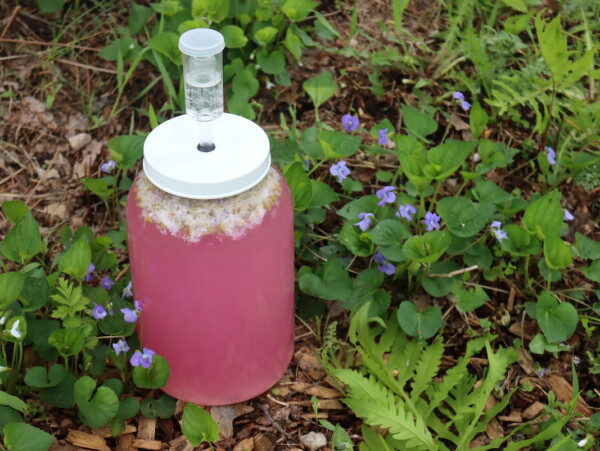










We racked the raspberry wine and put a water lock on it, should it start bubbling again or not?
It may or may not start visibly bubbling again. Secondary fermentation can be very slow, and you may not see it bubble (because it’s maybe only bubbling once every few hours), but it’s still changing and maturing.
If making 4 batches in a 5 gallon carboy how much yeast should I use. I have another recipe that just calls for 1 packet?
One yeast packet is enough for up to 5 gallons, so you’re good with one packet. The yeast rapidly multiply, so it’s just a starter population to get the batch going.
Thank you for this wonderful recipe. I have a question about the transfer of the wine from bucket to carboy. Do I transfer everything, including the sediments on the bottom and the raisins that I used for the yeast nutrients?
No, you want to leave the sediment and raisins behind.
hi! excited to use some of last years freezer stash to try something new! i followed the instructions and ended up w a good bit more then 1 gallon. I had a half gallon carboy but im a couple cups from it being filled- should i boil water first – let it cool then top it off?
TIA – maria
ps- im most excited about the lilac wine I made last summer- i tasted when bottling and cannot wait to open a bottle soon!
Yes, that should work just fine.
Nice post
Thank you. So glad you enjoyed it.
Thank you for this recipe! My husband has been making raspberry wine for a,couple of years and we love it! I’m wondering what I can use the raspberry pulp after it is done with it’s use in the wine? I hate to just throw it out. Thank you!
I am not aware of any good uses for it but if you find some let us know.
Thank you Ashley! I’ve got my raspberry mead going and look forward to trying the wine next year. I’ve also got some peach wine and trying to brew up some peach mead. Your simple explanation makes it easy to follow. I’m looking forward to many more batches of wine and mead. I’m so glad I found your blog. Thank you again. Laurie
Wonderful! So glad to have you along!